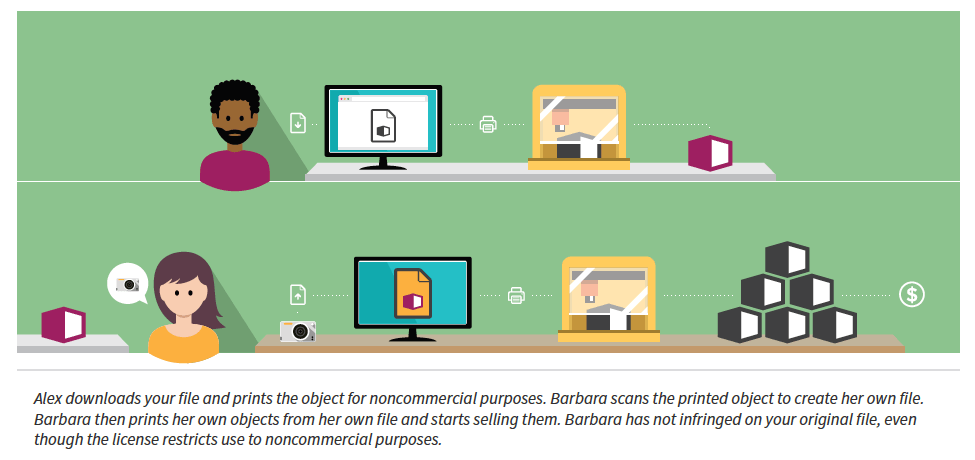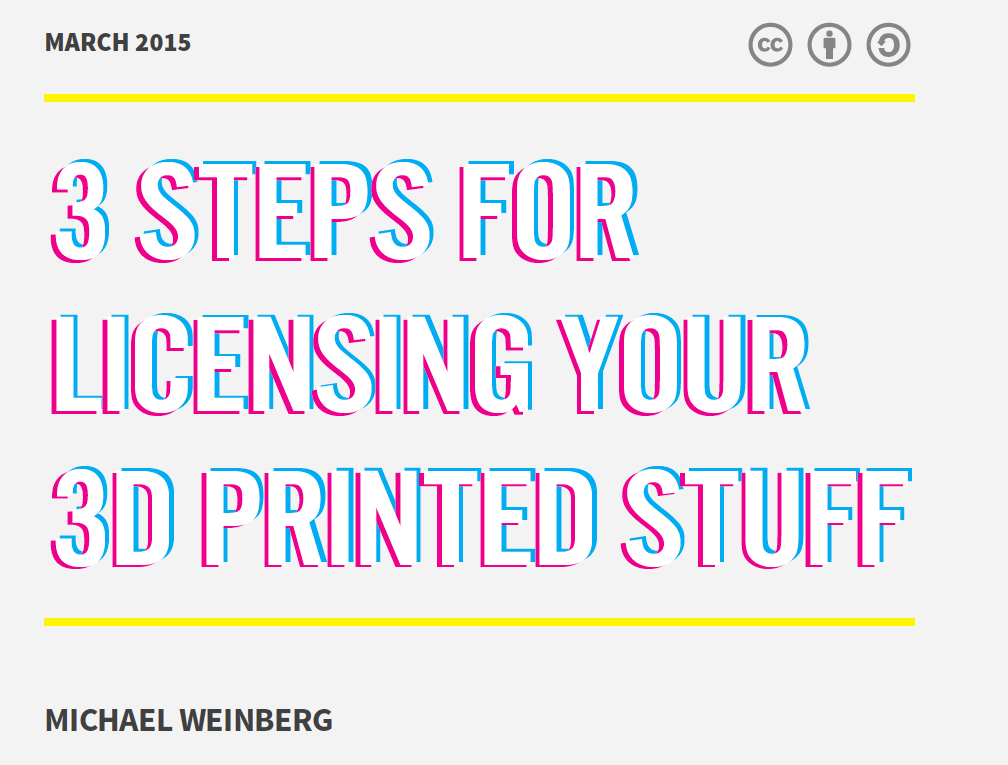Michael Weinberg Leads Us Through 3 Steps for Licensing 3D Printed Things
 As more and more people become involved in 3D printing, more and more awesome stuff is being created. The question that naturally arises after any particularly amazing print, or after a case of beer, whichever comes first, is how do I copyright this so that I eventually become a millionaire? I may be paraphrasing a bit, but understanding how exactly to license the cool stuff you have worked so hard to produce is actually an important question.
As more and more people become involved in 3D printing, more and more awesome stuff is being created. The question that naturally arises after any particularly amazing print, or after a case of beer, whichever comes first, is how do I copyright this so that I eventually become a millionaire? I may be paraphrasing a bit, but understanding how exactly to license the cool stuff you have worked so hard to produce is actually an important question.
In 2015, Michael Weinberg released a white paper that really got into the nitty gritty of what is actually possible in terms of licensing, and specifically in terms of open licenses, like the ones offered through Creative Commons. This is the kind of advice you should take to heart because it comes from someone with scads of legal expertise in 3D printing, no other than Shapeways’ general counsel.
 What Weinberg does in this paper is break down the process for deciding to copyright (or not) into three steps. The first is to determine what pieces or parts, if any, of your creation or its file might be eligible for copyright protection. Not every unique thing is something that can be copyrighted. In some cases, only individual parts of the overall creation could be copyrighted; in others, it might only be possible to copyright the digital file and not the object itself.
What Weinberg does in this paper is break down the process for deciding to copyright (or not) into three steps. The first is to determine what pieces or parts, if any, of your creation or its file might be eligible for copyright protection. Not every unique thing is something that can be copyrighted. In some cases, only individual parts of the overall creation could be copyrighted; in others, it might only be possible to copyright the digital file and not the object itself.
The second step in the copyright journey is to make sure that you understand what it is that a copyright does, and does not, do. This is an area that is often a quagmire of confusion as people are prone to believe that holding a copyright, in any form, on a digital file bestows upon them despotic control over the use of that file and/or the object that it is used to create. As Weinberg explains:
“Understanding what your copyright allows you to control – and what remains out of your control – is critical to thinking about how to license things. For example, you may have a copyright on a file that represents an object, but not on the object itself. In that case, you should be clear-eyed about the fact that even the most restrictive license on the file will not stop people from reproducing the object without your permission.”
 The third, and final step, is to chose the kind of license that more closely reflects the control you want to exercise over what it is that is legally possible for you to control. Although in all honesty, this is the step for which the paper offers the least information, but that’s because there are a bevy of extremely helpful resources already.
The third, and final step, is to chose the kind of license that more closely reflects the control you want to exercise over what it is that is legally possible for you to control. Although in all honesty, this is the step for which the paper offers the least information, but that’s because there are a bevy of extremely helpful resources already.
What’s best about this white paper is that it is an easy read, it’s well written, well organized, and well beyond the normal dry instruction manual issued to lull you to sleep before you can act. The real lesson here though is that none of this is as straightforward as we’d like to think and it’s going to be quite some time before that changes as so much of the ground covered by what is made possible through these technologies is really new territory. So, if you are sitting on something that is going to make you the next millionaire, you might want to get some expert advice. Discuss in the Licensing forum at 3DPB.com.
Subscribe to Our Email Newsletter
Stay up-to-date on all the latest news from the 3D printing industry and receive information and offers from third party vendors.
Print Services
You May Also Like
3D Printing News Briefs & Events Roundup: March 15, 2025
In this weekend’s combined 3D Printing News Briefs and Webinars/Events Roundup, we’re covering news about automotive and construction 3D printing, along with AM Forum, TCT Asia, the Experience Stratasys Tour,...
3D Printing News Briefs & Events Roundup: March 8, 2025
Starting this week, we’re shaking things up a little! We’ll be combining our 3D Printing News Briefs with a more curated weekly list of 3D printing webinars and events to...
Combinatory Manufacturing, Happening at Last?
In 2009, I introduced the concept of “combinatory manufacturing” while at Shapeways. This approach integrates 3D-printed components with conventionally manufactured ones to create end-use products. Unlike merely using 3D printing...
Boston’s Additive Edge: Fluent Metal’s Approach to Liquid Metal 3D Printing
Stepping into the heart of Boston’s innovation landscape, I found myself at Fluent Metal’s headquarters in Cambridge. From the moment I walked through the doors of the startup’s space, the...

























